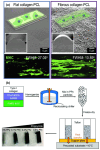Structuring the Future of Cultured Meat: Hybrid Gel-Based Scaffolds for Edibility and Functionality
- PMID: 40868741
- PMCID: PMC12385360
- DOI: 10.3390/gels11080610
Structuring the Future of Cultured Meat: Hybrid Gel-Based Scaffolds for Edibility and Functionality
Abstract
Cultured meat is emerging as a sustainable alternative to conventional animal agriculture, with scaffolds playing a central role in supporting cellular attachment, growth, and tissue maturation. This review focuses on the development of gel-based hybrid biomaterials that meet the dual requirements of biocompatibility and food safety. We explore recent advances in the use of naturally derived gel-forming polymers such as gelatin, chitosan, cellulose, alginate, and plant-based proteins as the structural backbone for edible scaffolds. Particular attention is given to the integration of food-grade functional additives into hydrogel-based scaffolds. These include nanocellulose, dietary fibers, modified starches, polyphenols, and enzymatic crosslinkers such as transglutaminase, which enhance mechanical stability, rheological properties, and cell-guidance capabilities. Rather than focusing on fabrication methods or individual case studies, this review emphasizes the material-centric design strategies for building scalable, printable, and digestible gel scaffolds suitable for cultured meat production. By systemically evaluating the role of each component in structural reinforcement and biological interaction, this work provides a comprehensive frame work for designing next-generation edible scaffold systems. Nonetheless, the field continues to face challenges, including structural optimization, regulatory validation, and scale-up, which are critical for future implementation. Ultimately, hybrid gel-based scaffolds are positioned as a foundational technology for advancing the functionality, manufacturability, and consumer readiness of cultured meat products, distinguishing this work from previous reviews. Unlike previous reviews that have focused primarily on fabrication techniques or tissue engineering applications, this review provides a uniquely food-centric perspective by systematically evaluating the compositional design of hybrid hydrogel-based scaffolds with edibility, scalability, and consumer acceptance in mind. Through a comparative analysis of food-safe additives and naturally derived biopolymers, this review establishes a framework that bridges biomaterials science and food engineering to advance the practical realization of cultured meat products.
Keywords: cultured meat; edible scaffolds; gel; hydrogel; natural polymers.
Conflict of interest statement
The authors declare no conflicts of interest. The funders had no role in the design of this study; in the collection, analyses, or interpretation of data; in the writing of the manuscript; or in the decision to publish the results.
Figures






References
-
- Ben-Arye T., Shandalov Y., Ben-Shaul S., Landau S., Zagury Y., Ianovici I., Lavon N., Levenberg S. Textured soy protein scaffolds enable the generation of three-dimensional bovine skeletal muscle tissue for cell-based meat. Nat. Food. 2020;1:210–220. doi: 10.1038/s43016-020-0046-5. - DOI
Publication types
Grants and funding
LinkOut - more resources
Full Text Sources

